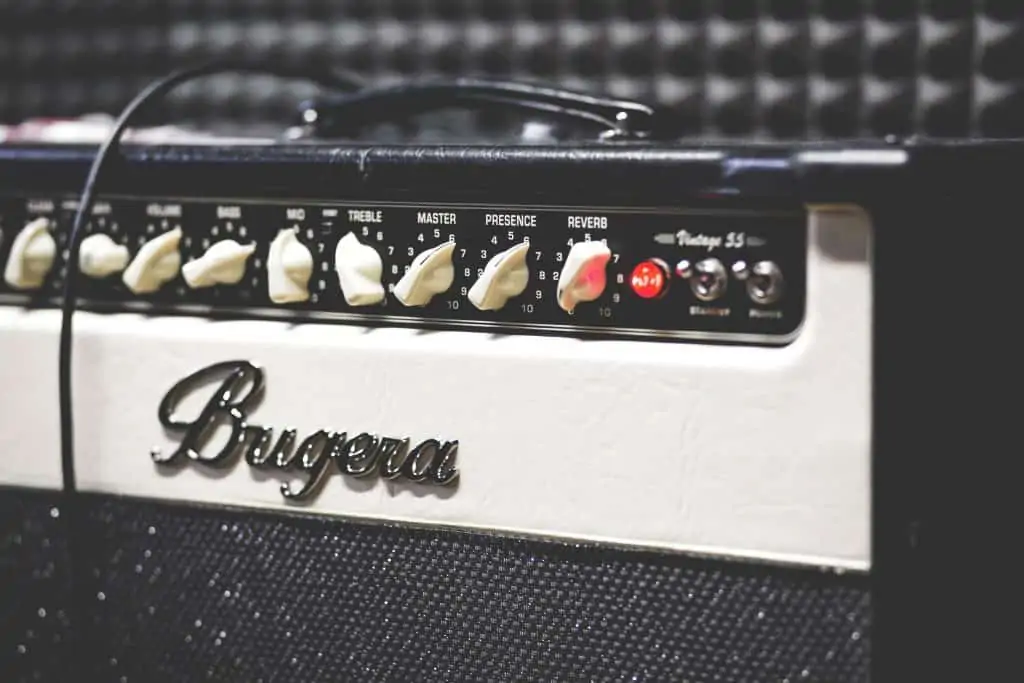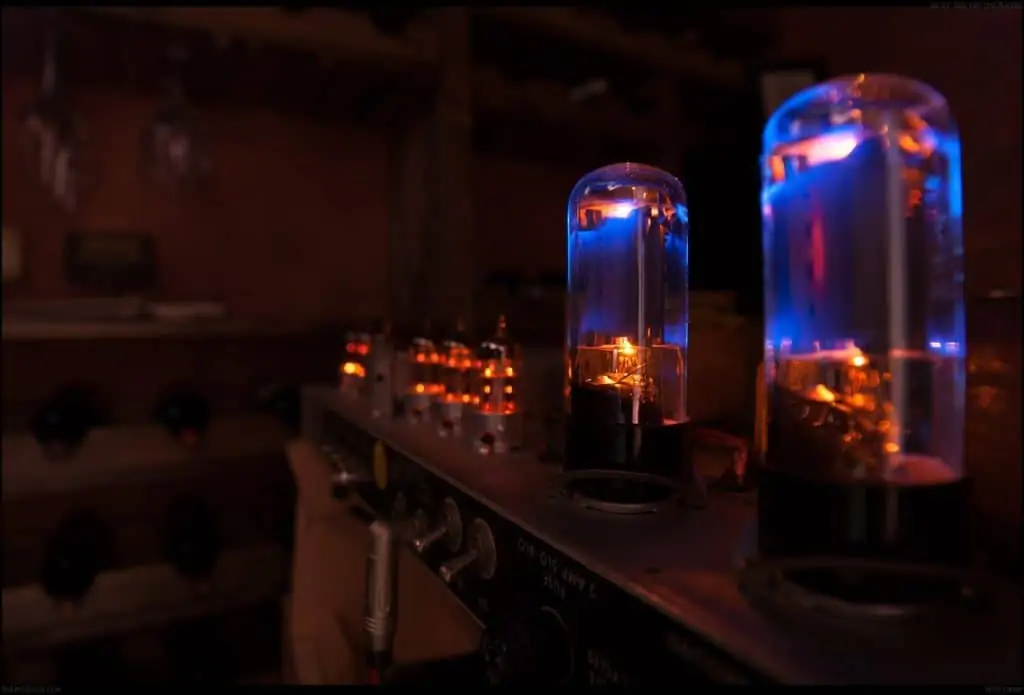Bugera is one of the first, and one of the single manufacturers still producing budget tubular guitar amplifiers.
The Bugera Trirec is not an example of what the brand usually offers, though. Whereas Bugera lives as a budget-minded builder of hand-made tubular amps, the Trirec model falls into the boutique category.
It has everything going on for it, except for the price. It’s a bit of a premium for a head amp but, if you take your sound seriously, it may be worth a look.
It’s also not selling as an elite super amp, but its price is above most solid-state models except, perhaps, the Roland JC-120.
But as it stands, the Bugera Trirec sounds and behaves like something else. You don’t have to spend thousands of dollars for a professional, tube-driven sound. This model, going for a mid-high price, provides everything you’d need on a simple and yet versatile control layout.
Beware: the Bugera Infinium series is made for metal and rock music mostly.
Bugera builds their speakers, valves, and circuitries. They also use both 3D-printed circuit boards as well as hand-wiring processes. Lastly, they tend to add proprietary tech to increase the lifespan of the circuits and the valves, as well as the sound and consistency.
Contents
Bugera TRIREC INFINIUM 100-Watts Valve Head Guitar Amp Review
The TriRec Infinium is one of the latest models from the brand. It’s a flagship model offering boutique sound and features.
We’re looking at an all-tubular, hand-wired, and hand-built 100-watt head amplifier. So, even though this is not a combo amp, the model is massive and can pack a super-serious punch without an extra cabinet.
It sounds crazy. A 100-watt head amp is not very common. Moreover, it can function at the studio and the stage at the same time.
For the stage, it has 100-watts of power that can reach everybody. For anything else, you can plug extra speakers or use a PA system. The head amp has three channels and a wide array of controls to tweak your sound.
For the studio, it has a line-out with its own level control so you can plug it directly into a mixer or an interface and record.
Also, I should say this is a Class A/B tubular amplifier. That means the tubes act as both transistors (to turn an electrical current into an audio signal) and preamp, thus delivering the best performance available for tubular amplifiers.
On top of this, the best part of the Trirec Infinium head amp is the proprietary Infinium technology, which increases the sound quality and durability of the valve tubes.
The amplifier sells with a Bugera footswitch.
Overview
Valve tubes can have plenty of tones, and so they need a fair choice of controls to work properly.
Enter the Trirec Infinium model, an all-tube model with 3-channels and advanced Varipower control that allows you to tweak the input from 1 to 100watts. That gives you the ability to practice at home, rehearsing, or recording at the studio.
On top of that, you have a custom high-definition Reverb effect that delivers the boutique sound only the best reverb pedals and amplifiers can give.
In all honesty, Bugera has had a rough ride to popularity. They achieved a top-tier reputation with affordable prices, and they are riding on their budget choices to sell their premium models as well.
If you’re looking for a heavy, rocker, modern, and feature-rich professional amplifier for less than $1000, the Bugera TriRec might be just for you.
Unfortunately, Bugera is not making the TriRec model anymore as they replaced it with another amp inspired by Mesa Boogie models. In fact, Bugera lists this head amp as a “legacy” product on their site.
We’ll discuss that on the alternatives below.
You could still find it only or used.
Features
The Bugera TriRec Infinium head amp is a feature-rich flagship model.
In particular, four core features set the amp apart from others:
- Infinium Technology
- Varipower
- Tubular design
- TriRec rectifier modes
Infinium technology
Let’s start by detailing the Trirec Infinium technology. The Infinium Tube Life Multiplier Technology can extend the usable time of the power tubes by 20 times, thus saving you a lot of money and time.
Most tube amps require you to change the valves every 6 months or so, otherwise, the sound loses its integrity. The Infinium tech both retains the integrity and the durability of the pieces.
The feature works by monitoring the performance of each tube to make them operate better. In other words, there’re voltage regulators on each power tube that ensure each piece evenly distributes the electrical signal.
By adjusting the current levels on each tube, these pieces can sound good as new for many years, even during voltage spikes.
Similar technologies also work on 4×4 traction cars. Some systems modulate the power going to each wheel to improve the traction.
The Infinium tech brings a secondary benefit. There’re LED lights next to each tube telling you the lifespan of the piece. That means the LED indicates you when to change a particular tube, all thanks to Trirec Infinium Auto-Bias design.
That saves you a trip to a guitar amp repair shop. You could simply buy a compatible tube (more on that later) and replace the particular piece that needs replacing.
Tubular amplifiers are the first kind of guitar amplifier to exists. As a vintage design, the sound they offer is all about vintage rock, blues, and jazz. Nowadays, most professional bands still use valve tubes.
Varipower feature
I should also name the Varipower feature. It allows you to attenuate the output so you can still push the tubes into optimal power without playing at its highest volumes.
The Varipower works through a knob that alters the output of the amplifier. It goes from full-stack and all-out power to room practice levels.
High-tech all-tubular design
The TriRec’s Auto-Bias design balances the four power tubes to deliver an optimum tone. Then, if a tube fails, a LED light indicates which one is going wrong.
There’s another side to this. Players can change and combine the tubes they’d like, as long as they are compatible. The TriRec head amp will adjust the power output automatically, so the user wouldn’t need to do anything else.
For tubes, this Class A/B amp uses 5 x 12AX7 front-end tubes plus 4 x 6L6 tubes on the power stage. The combination delivers a heavy-rocker sound, a natural compression, plenty of dynamics, and an excellent break-up tone.
The amplifier is also compatible with EL38 and 581 power tubes at any position. Because you can mix so many tube kinds (four-tube kinds, to be precise), you can discover plenty of unique sounds and tonal signatures.
Here’s a video showcasing what “Class A/B” means:
Rectifier section
The Bugera Trirec has 6L6 and 12AX7 tubes, as I said above. Aside from these tubes, there’re two 5U5 valves in the rectifier. The rectifier section is the section that turns the positive and negative AC currents coming from the preamp tube into a DC current for the power tubes.
The quality of the rectifier greatly influences the quality of the resulting tone.
Now, the Bugera TriRec head amp does something special for the rectifier. You can make them work in three different manners for different sounds:
- The “Valves” mode delivers a medium output;
- The “Valves & Diodes” mode delivers a low output;
- The “Silicon Diodes” mode delivers high output.
The rectifier selector is on the back of the amplifier.
Channels and controls
There’re three independent channels on the head amp. You can switch between them with an extra footswitch.
Each channel has a LED light indicating which one is working. You can also swap between them by pushing the LED light/button.
Each channel features identical control clusters. The knobs include treble, mid, bass, volume, gain, and presence.
The first two channels (left to right) have a pickup selector switch for classic/vintage / modern sounds. The third channel features a clean/dirty 2-way switch.
You would have to experiment to see how the channels differ in sounds. Overall, the first channel (left to right) is the heaviest. The middle one is about hard rock, and the third one features a regular clean/dirty switch, so it’s the one you would use if you have a lot of pedals.
The third channel is also the cleanest, softer one of the bunch.
Finally, the global control cluster has a master volume, a boost switch, reverb, and Varipower knobs.
I/O ports
The output options are equally plentiful and yet easy to understand.
First, there’s a line-out with a level knob. That allows you to plug the amplifier into interfaces, mixers, and similar devices. The level knob allows you to tweak the volume level in-house.
Then, there’s an impedance selector, which increases the compatibility of the Bugera Trirec with different audio devices. You can change 140, 80, and 60 Ohms.
Up next comes left & right outputs to create a stereo sound, if you ever need an uber wattage level.
Next to the speaker outputs, there’s an effect loop output with a channel selector switch. This section has send & return outputs for extra versatility and experimentation. The send & return outputs can work manually or automatically.
Rounding up the output options comes a footswitch connection plus individual external jacks for each channel.
The included footswitch connects to the five-pin jack and has options to turn each channel on and off. It can also engage boost, reverb, and the effects loop.
As for input options, the Bugera Trirec only includes the standard XLR input.
Lastly, the TriRec model supports MIDI remote switching, so it’s a great choice for complex sound rigs.
Performance
Now, the best thing about the Bugera TriRec head amp is its boutique tone. The performance and tonal shaping options are up there with the elite and rival the priciest models from brands like Marshall, Vox, or Mesa Boogie.
It offers beautiful and plentiful tones, all of them with genuine tubular projection and rectification. Add warmth, clarity, and natural clipping for a perfect result.
The clean is also gorgeous. It’s tight, focused, and with enough headroom to channel your whole pedalboard. The “drive” option also offers a solid layer of girth, gain, and texture.
If you don’t have clipping pedals like a fuzz, an overdrive, or a distortion, the higher-output channels are also perfect. Crank the diode rectification to its maximum setting, dial the Varipower knob, and hear the tubes scream.
In its full power, the tone is impressively heavy and aggressive. You can dial the tone to play all kinds of rock, blues, and metal music nonetheless.
Also, achieving the natural distortion tubular amps can deliver is easy enough. With the ability to set the amp’s output from one to 100, you can set the break-up point on any output level.
Here’s a heavy metal demo:
Alternatives
So far, everything I’ve said sounds perfect. There’s a catch, though, which is the availability of the amp.
As Bugera is no longer creating the TriRec model, you may have a hard time finding the model in your local store.
However, there’re newer models of the Infinium series, and I shall recommend to you the most similar alternatives.
First of all, there’s the 333XL Infinium Hardcore, a 120-watt head amplifier. It’s an all-tube, hand-wired model featuring similar specs and an easier layout.
Compared to the TriRec model, it’s missing the rectifier mode selector, the 3-way selector switch (classic, modern and vintage), and the Varipower knob.
It also adds 20 watts of power, the Infinium II technology, and a super-effective analog noise-gate.
Then, the layout is easier because the three channels (clean, crunch, and lead) share the same knobs.
So, it loses some versatility, but it adds extra durability, better quality tubes, and a better sound.
For a top-tier professional face-melting sound, this is the option that won’t make you go bankrupt:
Now, if you’re thinking of a budget alternative instead, there’s a 50-watt Infinium head amp. It sells for half the price and packs the same features. However, it will need speakers more often.
Another feature of its 2-channel design (clean/crunch) is a switchable rectifier operation. This time, it swaps from Class A to Class A/B modes for different amp voices (from warm to aggressive).
Lastly, if you’re thinking of a budget alternative, you could check our Bugera G5 head amp review.
In Summary
Why do I like the Bugera TriRec head amp?
There’s not much else to say. Topping the sound and features of the TriRec model is going to be very hard.
The 333XL has some tradeoffs but presents itself as an equally valuable alternative.
Both have enough power to play live, and enough quality to record professional music.
You don’t need to spend more than this. Brands like Mesa Boogie, Marshall, Fender, Vox, or Roland will deliver diminishing results as you go up the price ladder -if any. More so, those amps need constant maintenance, whereas the Infinium head amp does not.
Final Say
Are you into metal and rock music? Do you want a serious sound? Then, by all means, just buy it.



